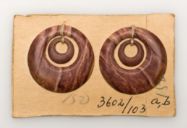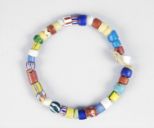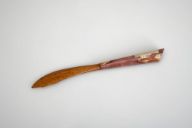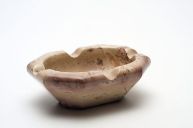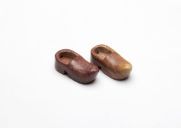Traveling bauxite
The first days of packing were hard on my grandmother. The three months that followed to get the work done were in no way easy, but they did bring us warmth and joy. Because her things were passing through her hands one by one, one story started to follow another. Next to just being what they are, bringing back memories is what things seem to do best. And sometimes the ugliest and bulkiest of things hide the dearest memories.
Take this vessel. For me, as a grandson, this was just one of those enigmatic objects in my grandparent's house. It had stood there for as long as I could remember, without me knowing what it was and what it contained. As with many of the larger objects in my grandmother's house, this vessel was brought from Suriname to the Netherlands by my grandfather, by boat. In the process of sorting things out, I wanted to move the vessel. The moment I lifted it off the ground, I immediately understood why it had never moved position before.
My grandmother started to share this object's story. The vessel was filled with bauxite, a rock that is the world's main source of aluminium. Bauxite plays a vital part in Suriname's economic history as well as in the country's collective memory. In the beginning of the 19th century, Suriname discovered the resource. In the century that followed, bauxite made up a substantial part of the national income. But was it so valuable that it was worth transporting to the Netherlands?
In the seventies my step-grandfather was visiting a friend who worked at Suralco, the US company that has been extracting bauxite in Suriname since 1915. The friend pointed at a vessel and told him that it was used to carry bauxite. My grandfather did not believe him, but before he knew it, he received a vessel filled to the brim with bauxite. This to his and, upon its arrival in the Netherlands, also to my grandmother's surprise.
As it often goes, one story rolls into the next. My grandmother told me that the bauxite tradition went deeper. In Suriname, bauxite is used to make decorative objects, jewels, and utensils. When I queried the Nationaal Museum Voor Wereldculturen database, I discovered to my surprise that apart from Surinamese objects made out of bauxite, the database also showed bauxite objects from West-Africa.
West-Africa is the area that supplied most of the slaves for the Dutch authorities in Suriname. Hence, a large part of today's population has its roots in West-Africa. Geologically, it is no coincidence that both West-Africa and Suriname have bauxite reserves. But is it a coincidence that the material culture around bauxite has taken on comparable forms? Or is this another example of traditions that found their way from Africa to Suriname by way of the slaves?
A month into packing and sorting, we started to think aloud about buying my grandmother's house. So we did.
She was ready to part with the vessel and wanted to leave it behind. My plan was to have it stand in the exact same position where it had stood for over thirty years, for as long as I can remember. But since objects carry memories, my uncle brought it back to his house. Because in the end, the fact that an object is bulky and unattractive, is irrelevant. What matters to my uncle is that this vessel brings back memories of his childhood home and of his late father.
